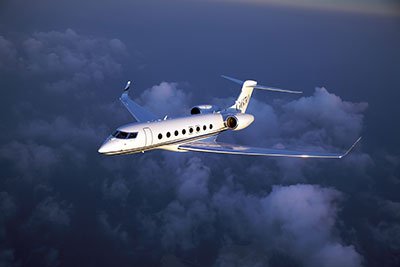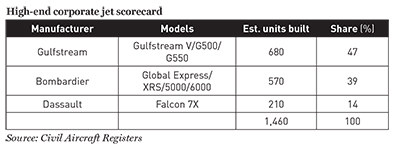
Features
Business Aviation
Gulfstream’s dynasty soars on
In the same way that Rolls-Royce is synonymous with the finest motorcars or Feadship is considered to be the most enduring brand of custom-built yachts, the Gulfstream name has long been associated with the grandest line of corporate aircraft.
September 9, 2013 By Frederick K. Larkin
In the same way that Rolls-Royce is synonymous with the finest motorcars or Feadship is considered to be the most enduring brand of custom-built yachts, the Gulfstream name has long been associated with the grandest line of corporate aircraft. While other manufacturers have gradually acquired meaningful shares of business aviation’s high-end market niche, the certification of the G650 has reconfirmed Gulfstream Aerospace’s reputation as the producer of the most prestigious purpose-built business jet.
 |
|
| The Gulfstream G650 project was announced in 2008 in response to significant customer demand for a larger cabin, a higher cruise speed and an even greater range. PHOTO: Gulfstream
|
The genesis of this impressive legacy was the decision by Grumman Aircraft Engineering Corporation in 1956 to develop a modern business aircraft that would replace the piston-pounding heavy iron of the post-Second World War era. Douglas DC-3s and Lockheed 18 Lodestars were the paragons of corporate fleets back then, but they flew low and slow.
Grumman wanted its new design to be pressurized and turbine-powered. The result was the G-159 Gulfstream, powered by a pair of Rolls-Royce Darts. The turboprop first took flight on August 14, 1958 and received its FAA certification on May 21, 1959.
Many Gulfstream operators app-reciated the G-159’s spacious cabin, but craved the shorter block times offered by smaller aircraft such as the Learjet, Jet Commander, Sabreliner, DH-125, Falcon and JetStar. Grumman responded to its market’s wishes and developed a suitable jet model. Equipped with two Rolls-Royce Spey turbofans, the Gulfstream II first flew on Oct. 2, 1966, and was granted its certificate on Oct. 19, 1967.
The ownership of the Gulfstreams’ manufacturer changed hands numerous times during the subsequent decades. Nonetheless, the company continued to design and build aircraft that could fly at greater speeds over longer distances in a more efficient manner.
The original Gulfstream’s cabin cross section was retained, although it was lengthened with every new generation, up to and including the G550. That model, certified on Aug. 14, 2003, boasted a range of 6,750 nautical miles (NM) at a cruise speed of Mach .80. It was impressive performance, especially when compared with the 3,345 NM that the Gulfstream II could traverse while cruising at Mach .75.
In response to significant customer demand for a larger cabin, a higher cruise speed and an even greater range, the Gulfstream G650 project was announced on March 13, 2008. Its initial flight on Nov. 25, 2009, was followed by a flight-test program that utilized five aircraft and led to Federal Aviation Administration (FAA) certification on Sept. 7, 2012. The first delivery to a customer took place on Dec. 20, 2012. Seven months later there were more than two dozen G650s in service.
The Gulfstream genealogy
The G650 is assembled at Savannah, Ga. in a new 200,000-square-foot facility that is dedicated to the model. The plant has twin production lines, is highly automated and utilizes advanced manufacturing tools, precision assembly methods and new materials such as bonded skins.
This has resulted in a dramatic improvement in build quality. The claim that the G650 is a clean sheet design can be confirmed with the knowledge that a G650 is manufactured with approximately 50 per cent fewer parts than a G550.
The purchase price of a new G650 includes a fully completed aircraft. The installation of the interiors and avionics and the exterior painting, is done at Gulfstream’s completion centres located in Savannah, Ga., Appleton, Wis. and Long Beach, Calif.

|
The competitive landscape
At the extreme upper end of the corporate aircraft market, three players compete. Ignoring executive configured commercial airliners, the three manufacturers of the largest purpose-built bizjets are Bombardier, Dassault and Gulfstream. Based on the estimated number of units built so far (excluding the G650), their shares of that prestigious niche are approximately 39 per cent, 14 per cent and 47 per cent, respectively. Details are provided in the accompanying table.
If the fact that more than 1,500 corporate aircraft priced at upwards of $50 million apiece have been purchased is a challenge to fathom, it is even more intriguing to know that the current offerings of those models all have healthy order backlogs. It’s little surprise then that the $64.5 million G650 is so much
in demand.
A summary of the specifications and performance of the Gulfstream G650 and those of its closest competitors, including a sibling, are outlined in the accompanying table below.
A buyer’s profile
The companies that currently operate G650s are global leaders in their respective lines of business. Some of their industries have experienced significant growth during the past decade and together they are a reflection of the world’s economy in the 21st century.
These corporations have seen their operational footprints expand at great rates as well, thereby requiring personnel to be on hand to oversee production, facility expansion or a strategic acquisition.
Industries represented by G650 owners include athletic apparel and equipment, energy, entertainment and media, discount merchandising, global cruises, industrial technology, private equity asset management, resort and casino hotels, and telecom technology.

|
The Canadian context
Not surprisingly, Canada has become a challenging market for Gulfstream over the past 30 years. That wasn’t always the case, considering that the first Gulfstream purchased in Canada was the seventh G-159 built. “CF-LOO” was delivered to its base at Calgary in late 1959. Similarly, two of the first nine Gulfstream IIs built were delivered to Canadian buyers in 1968.
Besides being a relatively small market, with somewhat conservative spending habits, Canada is after all Bombardier’s home territory. Its Challenger product line has kept a lid on the number of Gulfstream IIIs and IVs purchased by Canadians since the early ’80s.
Today, there are five fifth-generation Gulfstreams operated by Canadian interests, including two on the U.S. register. There are a baker’s dozen Bombardier Global models owned by Canadian companies, excluding the manufacturer, as well as five Dassault Falcon 7Xs based in Canada.
Over the horizon
One characteristic that remains constant in the business of producing top-shelf business aircraft is the spirit of competition amongst the participants. The launch of the G650 project back in March 2008 did not go unnoticed. On Oct. 16, 2010, a volley aimed at Savannah was let loose from Montreal – and it was double barreled.
Recognizing that cabin comfort, range and speed are key considerations in the selection of any business aircraft, Bombardier announced an expansion of its Global family that would meet the needs of its most demanding customers.
The Global 7000 will feature a cabin, including the baggage hold, that is 13 per cent larger than that of the G650. It is being designed to travel 7,300 NM at a cruise speed of Mach .85. On those occasions when time is really important, it will be expected to cover 5,100 NM at Mach .90.
If range is the key criterion in selecting an aircraft, the Global 8000 fits the bill. While its cabin will be four per cent smaller than that of the G650, it should be able to move a corporation’s team 7,900 NM at Mach .85 or take them between points that are 5,650 NM apart while clipping along at Mach .90.
While these two new models will retain the cabin cross section of the current Global family members, they will have newly designed airfoils and sport next-generation General Electric Passport high-bypass turbofan engines that are due to be certified in 2015. Bombardier forecasts that the Global 7000 and the Global 8000 will enter service in 2016 and 2017, respectively. Based on these preliminary statistics, the Gulfstream G650 with its 6,000 NM range, will still be able to outrun the two new Globals when sprinting at Mach .90, and it’s in service now.
 |
Prospecting the future
Has the weakened condition of the world’s economy had an impact on Gulfstream’s ability to sell the G650? Apparently not, as more than 200 units have been sold to date. Approximately 40 per cent of the orders have come from North America and about 23 per cent are from the Asia-Pacific region.
Based on the ownership of the smaller G550, the balance of the G650 orders are most likely from the Middle East, Russia and Europe. The airplane’s significant order backlog takes production out to 2017, which is an enviable position to be in during a period of reduced economic growth.
If brand loyalty serves as an accurate indicator of any product’s acceptance in a given market, then Gulfstream has some very long-term admirers amongst its clientele. No fewer than 14 customers have operated one or more examples of each of the first five generations of Gulfstreams over the past half-century. Today, three of those 14 organizations are operating a sixth-generation Gulfstream. It would not be surprising to see some of the other 11 follow suit in due course.
For more than 50 years, Gulfstream has been the standard of elegance in business aircraft design. With the addition of the G650, the reign of this dynamic dynasty has been extended.